|
Even before the Army finished the Mortar Battery, the first and largest Endicott-era fortification on Davids Island, it built another small battery nearby. This battery did not have a formal name when it existed, but is now known to historians as Battery Practice.
Rodman Guns
Completed in about 1893 Battery Practice was a fraction of the size of the Endicott-era batteries and originally mounted two nearly-obsolete artillery pieces. These armaments were Rodman guns, cast-iron, smoothbore, muzzle-loading heavy cannons, which were state-of-the-art during the Civil War.
The method of casting these cannons and the development of the gunpowder used with them resulted from careful experimentation by Lt. Col. (Bvt. Brig. Gen.) Thomas Jackson Rodman of the U.S. Army Ordnance Department in the 1840s and 1850s. (Genealogists are divided about whether Col. Rodman was a descendant of the 18th-century Joseph Rodman family, one-time owners of Davids Island and of nearby Davenport Neck on the New Rochelle mainland.)
The Army purchased hundreds of Rodman guns in several sizes during and shortly after the Civil War. Until nearly the end of the 19th century Rodman guns were the principal armament of American seacoast forts.
By the 1880s, however, advances in the design and manufacture of artillery rendered Rodman guns increasingly outmoded. Steel replaced cast iron for the manufacture of artillery, and built-up forging replaced one-piece casting. Rifled barrels superseded smoothbores. Breech-loading supplanted muzzle-loading. Carriages for guns incorporated precision aiming devices and hydraulic dampers.
These developments increased the range, accuracy and destructive force of artillery manufactured from the 1880s onwards. The capabilities of the newer guns far exceeded even the most advanced weapons of the Civil War. Yet, since in the 1880s and 1890s America’s need for seacoast artillery exceeded the availability of more modern weapons, Rodman guns remained in limited service until just after 1900.
Battery Practice
01-NARA SAL-3 Civil War No. 64 cmA 15-inch Rodman gun in a temporary emplacement at Battery Rodgers, Alexandria, Virginia, during the Civil War. The same type of artillery was used at Fort Slocum in the 1890s in a similar emplacement (National Archives digital collections). 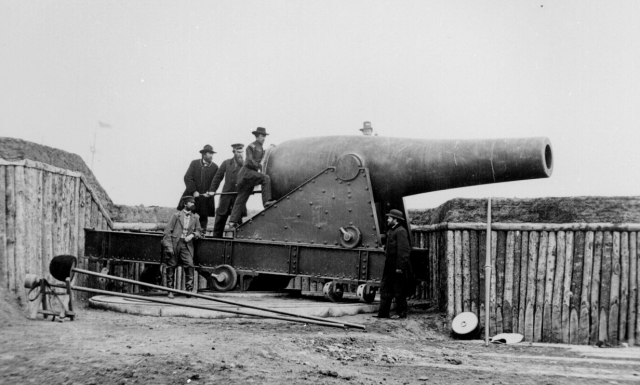  02-Ft Monroe Water Battery Rodman Firing ca 1902 PThe U.S. Army used Rodman guns until the beginning of the 20th century. Here, a 15-inch Rodman is fired from Fort Monroe, Virginia, around 1900. 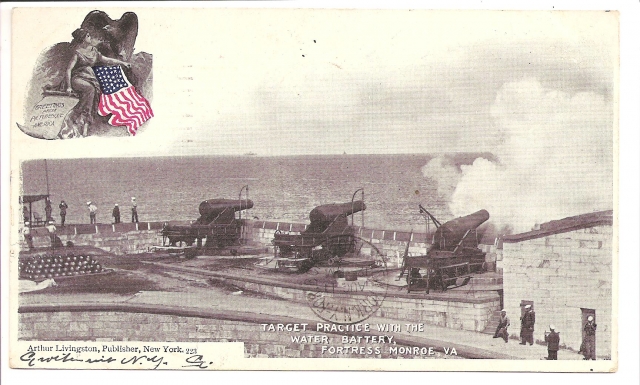  03-Map Ft Slocum-Hodges 1906-Old Battery detailSketch plan drawn in 1906 of Fort Slocum's Battery Practice (the "Old Battery"). Rectangular structure on the parapet is a searchlight shelter, built in about 1905, a few years after removal of the battery's guns.   04-Cav 4W A-151 up rt - Practice cSketch plan of Battery Practice in 1898, listing its armaments. 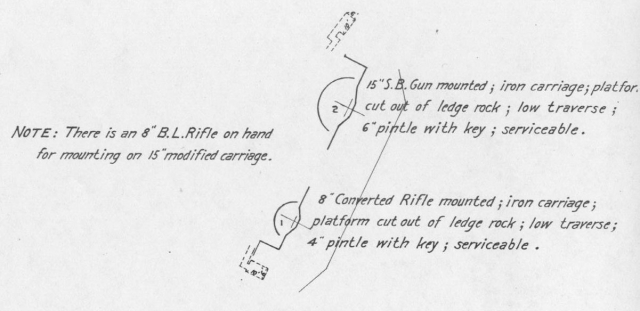  05-aerial 1932 11 jan horse corral Battery PractiAerial view of Battery Practice and vicinity, January 1932. Concrete retaining wall and earth parapet are visible behind tall chimney at center right.   06-IMGP3509 rConcrete retaining wall for the earth parapet (now removed), Battery Practice, looking south, November 2007--the last remnant of the battery. 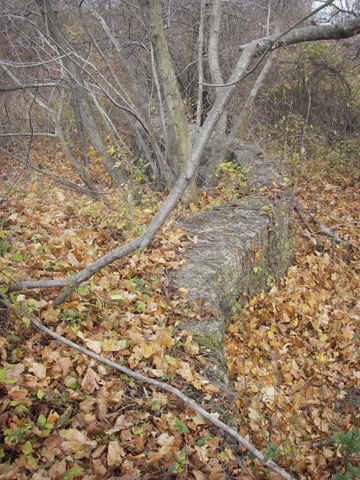  07-Cavanaugh 4W 158 Rodman c 1910Early postcard of Fort Slocum's Rodman Gun Monument looking east from near the Passenger Dock, circa 1910.   08-Cav 4W A-61View of the Rodman Gun Monument in the 1940s, looking northeast toward the Commanding Officer's Quarters (Building 1) 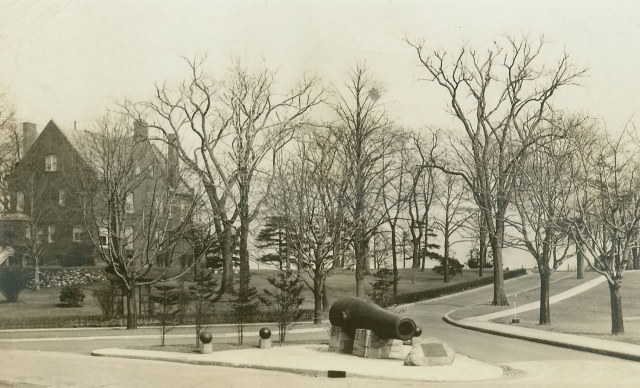  09-gun Rodman clear plaque  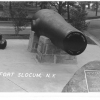 10-Fort_Slocum_Medical_Corps ggbain LC cmA group of medical corpsmen pose on the Rodman Gun Monument during the First World War. 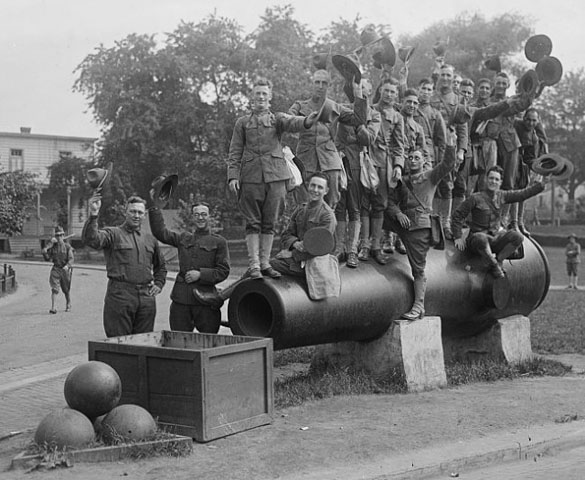  11-IMGP0214Looking east at the Rodman Gun Monument, one of the traces of Fort Slocum still visible on Davids Island, in December 2008. 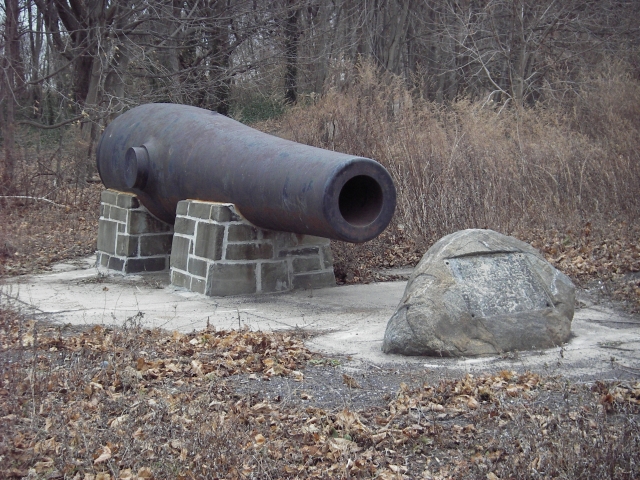 
Battery Practice
No less an authority than Col. Henry L. Abbot, whose tactical concepts led to the design of Fort Slocum’s Mortar Battery, considered Rodman guns still to be of some value in coastal defense near the end of the 19th century. The old guns, Col. Abbot believed, could defend the minefields the Army would lay at the mouths of harbors in time of war against lightly-armored enemy craft sent to clear a path through the mines.
Army officers regarded the most powerful widely-available Rodman guns, with a caliber of 15 inches, as the most suitable for such purposes. While these guns were used as smoothbores, the barrels of some smaller Rodmans were retrofitted with a rifled sleeve, which increased their range and accuracy.
Fort Slocum’s Battery Practice originally mounted one 15-inch smoothbore gun and one 10-inch gun retrofitted with an 8-inch rifled sleeve. These occupied adjoining emplacements behind an earth parapet supported on the interior by a concrete wall.
The purpose of the battery, however, is unclear. Was it, as one late 19th-century document indicates, simply a battery for target practice? Or was it a stopgap defense work installed as the international tensions that led to the Spanish-American War were escalating?
From Battery to Monument
Around 1898 the Army replaced the 15-inch smoothbore Rodman gun with what must have been a newer 8-inch breech-loading rifled artillery piece. Battery Practice apparently continued in use for a few more years, but by the end of 1902 it had been deactivated and its guns removed.
After dismounting the 15-inch gun from Battery Practice, the Army moved it across Davids Island to the Quartermaster Area. This gun became the centerpiece of the Rodman Gun Monument, which greeted visitors as they stepped onto Fort Slocum from the Passenger Dock. The whereabouts of the other two guns that once armed Battery Practice is unknown.
Soon after deactivation the battery became the site of the post’s powerful searchlight, which was used in conjunction with the Mortar Battery and direct-fire batteries. It was later used for coal and ash storage. The battery’s earthwork was eventually demolished, and all that remains of the battery today is a low concrete wall nearly hidden in a tangle of vines and shrubs.
|


























